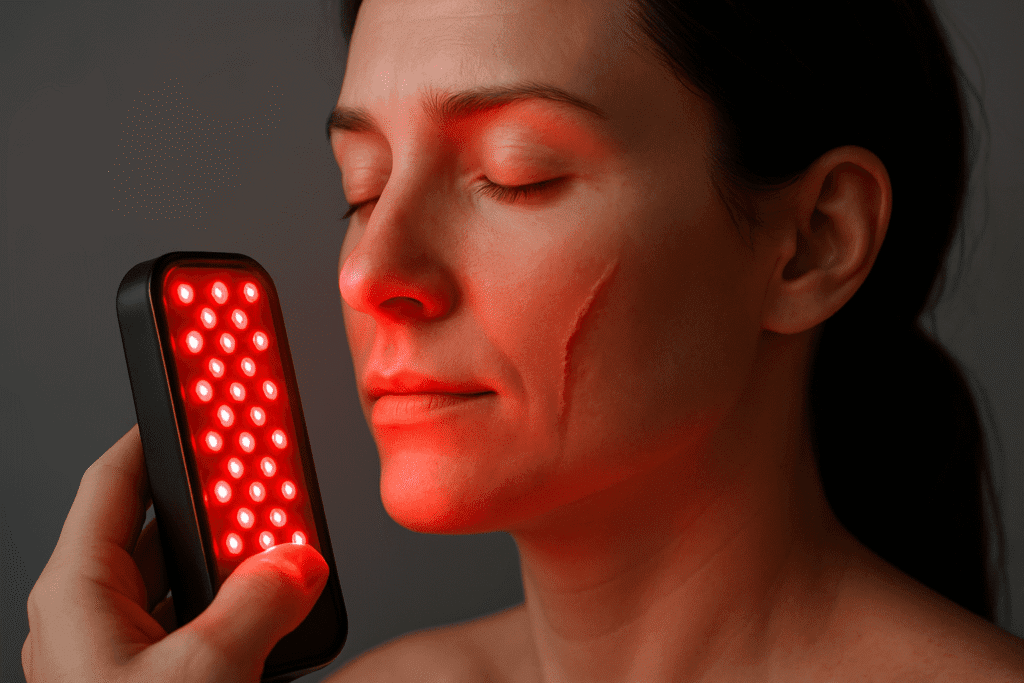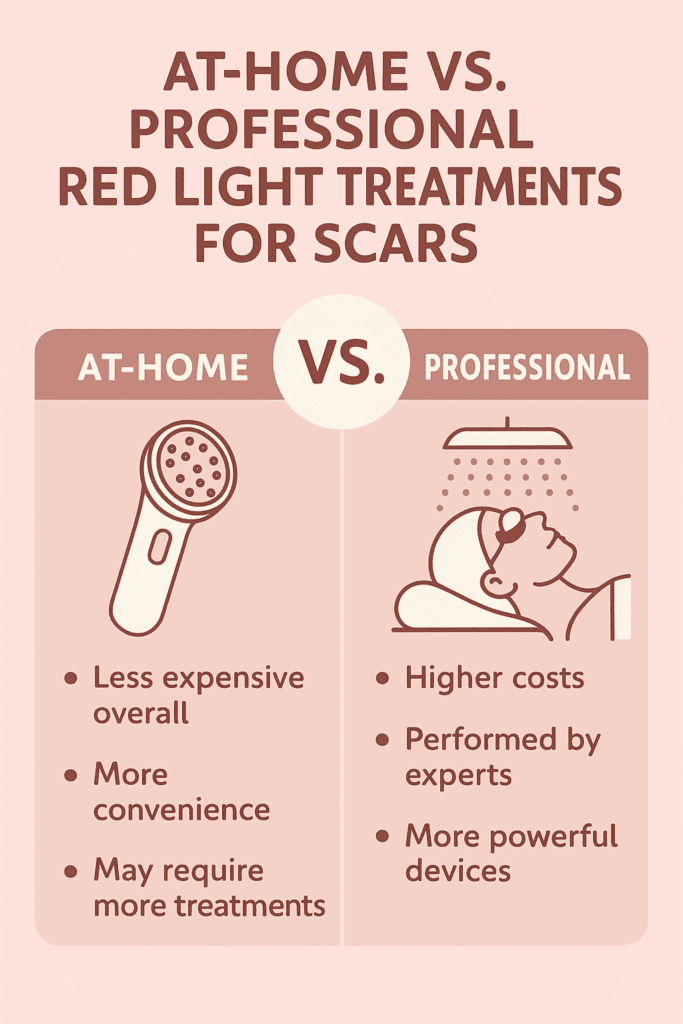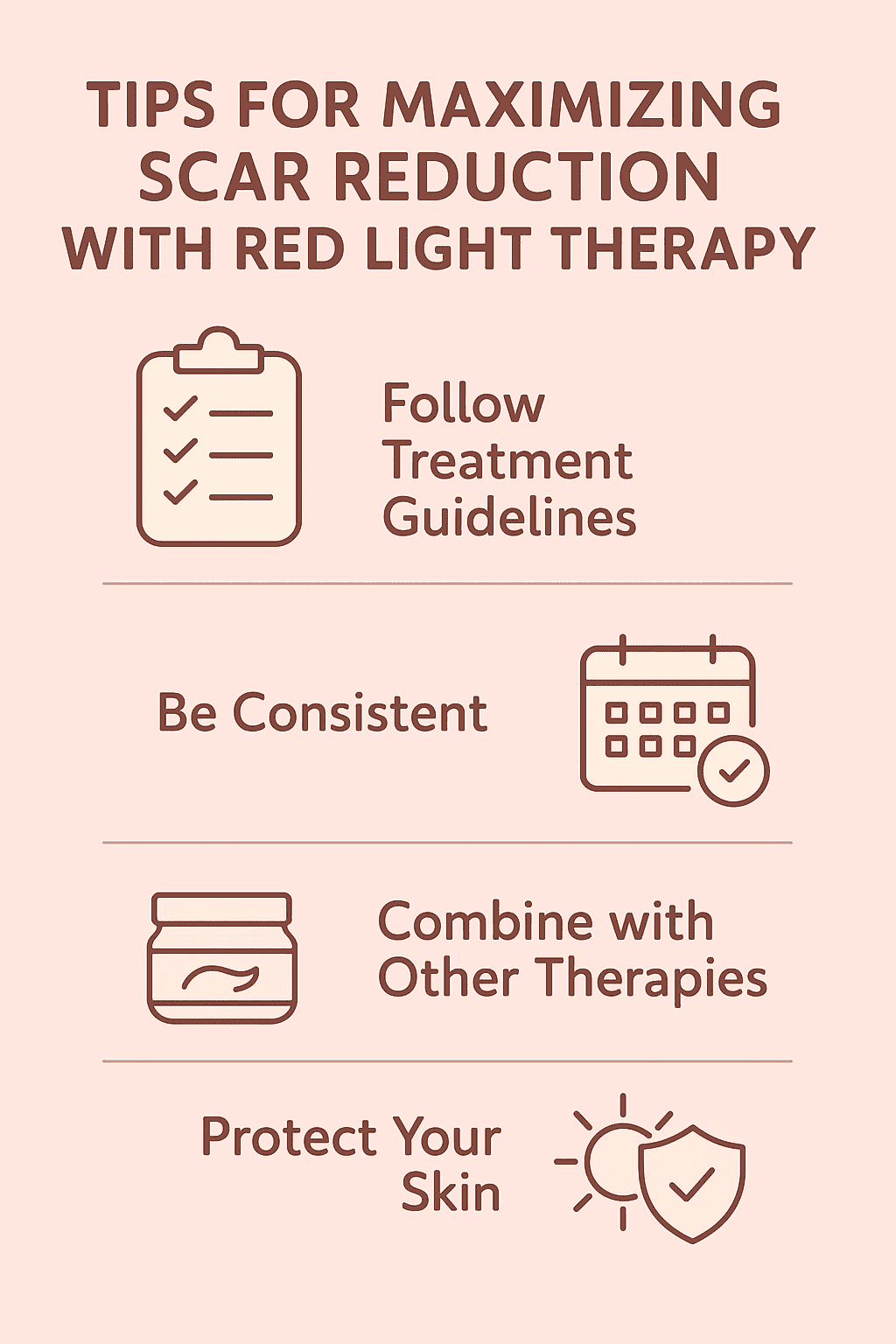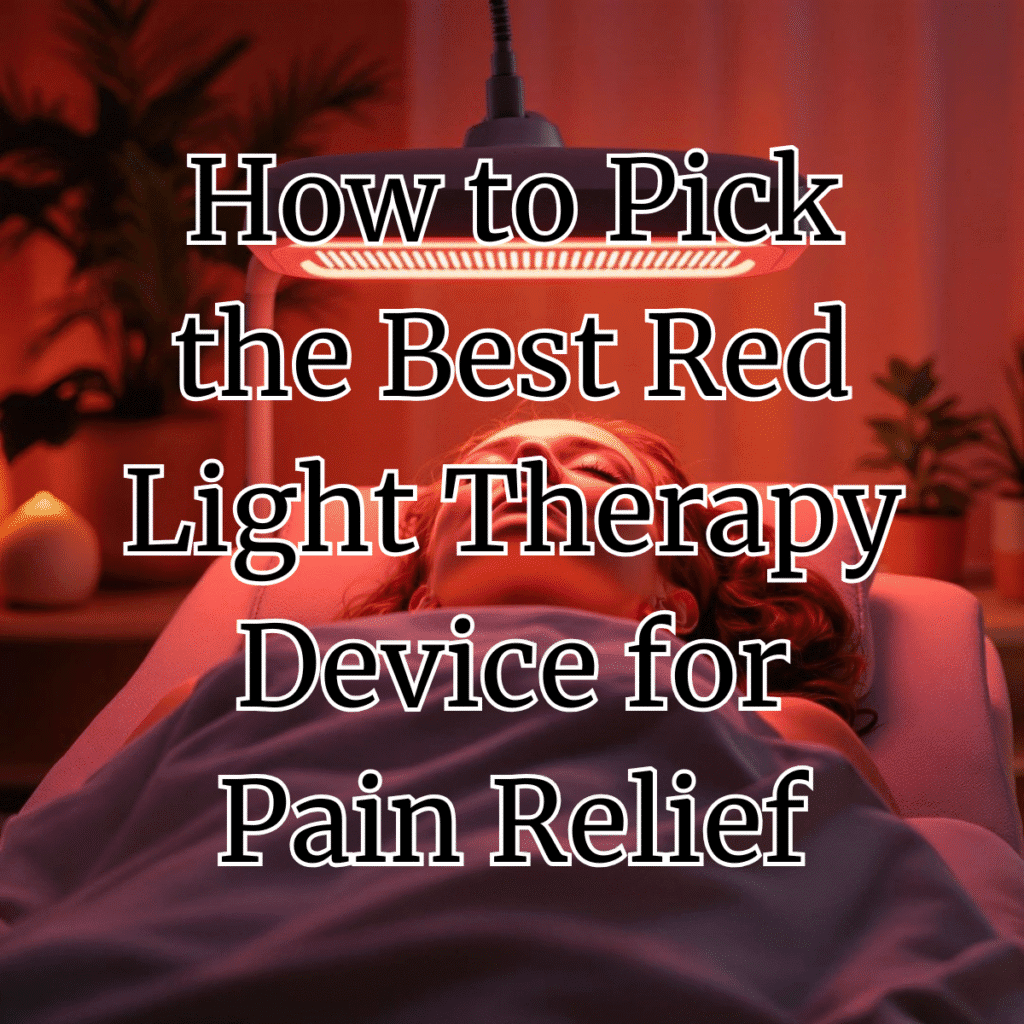Introduction: Scars tell a story of injuries healed, but sometimes we’d prefer those stories not be so visible. Whether it’s acne pitting on the cheeks, a surgical scar across the abdomen, or stretch marks from growth and pregnancy (which are a type of scar), many people seek ways to reduce the appearance of scars. Enter red light therapy (RLT) – a non-invasive treatment that’s gaining popularity for scar care and skin rejuvenation. RLT, also known as low-level laser therapy or photobiomodulation, uses specific wavelengths of light (usually red and near-infrared) to stimulate the skin’s natural healing processes.

This comprehensive guide will explore how red light therapy can help fade and soften scars, highlight the latest scientific findings and expert views on its efficacy, and provide a buyer’s guide and usage tips for those looking to try RLT as a scar treatment.
How Does Red Light Therapy Improve Scars?
To understand how RLT affects scars, it helps to know what a scar is. Scars are made of collagen fibers that repaired a wound, but they’re often disorganized compared to normal skin collagen. This can result in a different texture, color, or thickness than surrounding skin. Red light therapy works on a cellular level to influence how skin cells function and regenerate, which can gradually remodel scar tissue closer to normal skin.
Key mechanisms by which RLT can help scars include:
- Stimulating Collagen Remodeling: Red light stimulates fibroblasts – the cells responsible for producing collagen and elastin. In scars, fibroblasts sometimes either overproduce collagen (hypertrophic or keloid scars) or underproduce organized collagen (atrophic scars like acne pits). RLT helps regulate fibroblast activity, encouraging the deposition of new, healthy collagen fibers and the enzyme activity that can break down excess old scar collagen. Over time, this can flatten raised scars and fill in indented scars by improving the collagen matrix. A study noted that red light (around 660 nm) increased expression of collagen in human skin and boosted production of beneficial extracellular matrix component.
- Increasing Blood Flow and Oxygenation: Scar tissue often has poorer blood circulation than normal skin. RLT causes a release of nitric oxide in blood vessels, which leads to vasodilation (widening of blood vessels) in the treated area. Improved microcirculation means more oxygen and nutrients are delivered to the scar site, which can enhance the skin’s remodeling and natural fading processes. Better blood flow can also give scars a more normal color (for example, longstanding scars can be purplish or white due to altered circulation; RLT may help normalize this).
- Reducing Inflammation: Chronic low-level inflammation can make scars look worse (red, raised, itchy). Red light’s anti-inflammatory effect can calm this down, aiding scars to mature into a paler, softer state more quickly. For instance, in early scar formation (post-surgery or injury), using RLT might prevent excessive inflammatory signals that lead to heavy scarring. Even in older scars, reducing inflammation can diminish redness or discomfort.
- Accelerating Cell Turnover and Regeneration: Red light gives an energy boost (via mitochondria) to skin cells, meaning cells repair and regenerate faster. In practical terms, this can result in the scarred skin being replaced more rapidly by fresh skin cells, gradually blending the scar with surrounding skin. For example, hyperpigmented scars (dark marks) might fade faster as the pigmented cells turnover, and rough texture might smooth out as new cells form.
- Enhancing Skin Elasticity: Scars can feel tight or stiff. By promoting elastin production and more normalized tissue, RLT can improve the flexibility of scar tissue. People often report scars feeling softer and more pliable after consistent red light therapy, which is especially helpful for scars over joints or on the face where skin movement is important.
A classic example of RLT in action is its use by NASA and subsequently by clinicians for wound healing – it was found that red light could speed up the healing of wounds and reduce scar formation in the process. Building on that, many cosmetic and dermatology practices now incorporate LED light therapy after procedures like laser resurfacing or surgery to help the skin heal better and scar less. The FDA has even cleared some red light devices for improving skin texture and reducing wrinkles and fine lines, which share a similar collagen-boosting premise as scar reduction. While wrinkles and scars are not identical, both benefit from collagen remodeling and improved skin quality.
Scientific Insights and Expert Opinions on Scar Treatment with RLT
Does red light therapy truly make a difference in scars? A growing body of evidence and clinical experience suggests yes – especially when used as part of a comprehensive scar management plan. Here are some notable insights:
- Clinical Studies: Research has been done on RLT for various types of scars. For instance, one study on patients with recent surgical scars found that applying low-level laser light (in the red/infrared spectrum) to the incision area several times a week led to softer, less visible scars compared to untreated incisions.

Another investigation looked at patients who had undergone cosmetic surgery and found that those who received RLT on their incisions healed with better cosmetic outcomes (finer scars) and reported less pain, too. There’s also evidence from in vitro (lab) studies that red light influences gene expression in skin cells related to matrix remodeling – for example, upregulating MMPs (enzymes that can remodel collagen) in a controlled way.
- A 2024 systematic review of light therapy in wound healing noted that low-level light significantly improved healing times and scar outcomes in a majority of the studies reviewed. It highlighted that about 92% of patients in visible light therapy studies had partial remission of lesions (including wounds and related scars). While that stat is broad (covering acne etc., not just scars), it underlines that light therapy often leads to some positive change in skin lesions.
- Dermatologist Views: Dermatologists acknowledge RLT as a helpful adjunct for scar treatment. Cleveland Clinic, a leading medical institution, states that red light therapy is an “emerging treatment that’s showing promise in treating… scars”. They emphasize that more research is needed for absolute claims, but current results are encouraging enough that some dermatologists incorporate home LED use into scar care recommendations. Particularly for acne scars, doctors may recommend red light therapy to their patients in conjunction with microneedling or peels, as it can speed healing between treatments and amplify collagen production. In cases of hypertrophic scars or keloids, specialists sometimes use steroid injections or laser, but adding RLT could help diminish redness and itch in those scars and potentially enhance the flattening effect.
- Patient and Surgeon Experiences: Plastic surgeons have reported that patients who use red light around their incision sites (once the wounds are closed) often have better scar outcomes – thinner, more pliable scars – than expected. Patients also frequently note subjective improvements: scars becoming lighter in color and blending more with their skin tone after a few months of periodic RLT use. Athletes or individuals who had orthopedic surgeries sometimes use red light panels on their incision scars and anecdotal accounts mention the scars feeling less stiff, which can aid in rehab exercises because the tissue doesn’t restrict movement as much.
- For acne scars, which are typically pitted, a 2018 review in Journal of Clinical Aesthetic Dermatology by Ablon found that LED phototherapy can induce “statistically significant improvement” in skin texture and scarring when used over several weeks. It’s not going to erase deep “icepick” scars on its own, but combined with things like fractional laser or microneedling, it can accelerate results and further stimulate collagen in between those more aggressive treatments.
To illustrate, consider someone with acne scars: Red light therapy will stimulate collagen under the pits, gradually “plumping” them from beneath. One small trial saw some subjects achieving nearly 90% reduction in inflammatory acne lesions with red LED, and while that study was about active acne, many of those patients also had scars that improved as a side effect (fewer breakouts plus the collagen boost helped smooth the old scars). Similarly, think about someone post-surgery: their scar passes through phases – initial redness and elevation, then maturation. If they use RLT during the healing phase (after sutures are out and skin is intact), it can expedite the scar’s maturation, resulting in a flatter, lighter scar sooner than it normally would.
One point to manage expectations: Time is a factor. Scar remodeling is a slow process. RLT is not a quick fix, but a catalyst to the body’s natural scar fading process. You might need consistent treatment for a few months to see noticeable changes in an older scar, whereas newer scars might respond faster because they’re still in the active remodeling stage. Patience and consistency are key, as our experts and evidence suggest.
At-Home vs. Professional Red Light Treatments for Scars
Both at-home and professional RLT can be effective for scars, and often they are used complementarily.
- Professional RLT: Some dermatology clinics or medspas offer LED light therapy as part of scar treatment packages. This could be after a procedure – for example, after laser resurfacing for acne scars, many clinics will put you under a red/infrared LED panel to calm inflammation and kickstart healing. Or a plastic surgeon might include a few LED sessions in the post-op care for a facelift or tummy-tuck patient to optimize the scars. The advantage of in-office treatments is that they might have higher-powered, large panels that can treat a broad area with a very uniform dose. The session is supervised, and combined with other modalities (like application of growth factor serums under the light, etc.). However, going to a clinic multiple times a week just for light therapy can be impractical and costly for many – insurance typically won’t cover LED for cosmetic scar improvement, only maybe for chronic non-healing wounds. So, in-office RLT might be a nice bonus if you’re already in a procedure or therapy, but not a long-term solution for daily scar care.

- At-Home RLT: The practicality of treating scars at home cannot be overstated. Most scars will need long-term attention (weeks to months), and home devices let you do this conveniently. At-home RLT devices come in various forms as discussed in earlier sections. For scars specifically:
- If it’s facial scars (acne scars, etc.), an LED face mask or panel is great to cover the area.
- For larger body scars (like from surgery or burns), you may consider a handheld panel or a therapy lamp that can be positioned over the area. There are also flexible LED mats that can wrap around limbs or cover the torso.
- For small scars (like a C-section scar or a biopsy scar), even a small handheld LED probe can be moved along the scar.
At-home devices tend to be less powerful than huge clinic machines, but they are still effective with consistent use because you can use them more frequently. And because they’re lower power, the risk of any adverse effect is extremely low – you’re not going to “overdose” your skin on light easily if you follow instructions.
One popular routine for at-home scar care is: use the red light device daily or every other day on the scar for ~10-15 minutes, and also apply any topical scar creams (like silicone gel or vitamin E) as recommended – you can even apply them after the light session to get combined benefit. There’s evidence that combining therapies is best: e.g., one study found that when low-level laser was combined with a topical salicylic acid in acne scars, results were superior than either alone. Similarly, using silicone sheets plus RLT on a hypertrophic scar might flatten it faster than either alone.
Choosing a Red Light Therapy Device for Scar Treatment (Buyer’s Guide)
When picking a device specifically for improving scars, consider the following factors:
- Target Area and Size: Identify how large the scarred area is. If you have many small acne scars across your face, a full-face device is convenient. If you have a long surgical scar (e.g., knee replacement scar, C-section, mastectomy scar), a handheld panel you can run along the scar or a medium-size pad might be better. For widespread issues like stretch marks across the abdomen (which are essentially dermal scars), you might want a larger panel or LED bed to cover the zone in a reasonable time. Some devices allow you to treat an area of about 6”x8” at once, while others cover the entire back or torso. Balance budget with coverage – you can always treat in sections if needed, but if it’s too time-consuming you may not keep up with it.
- Wavelength Specifications: For scars, look for devices that specifically mention red (around 630–670 nm) and infrared (around 800–880 nm) wavelengths. These are the wavelengths that penetrate deep into the dermis where scar collagen lies. Infrared, in particular, penetrates the deepest (it’s invisible but often included in devices). Some devices also have blue light – that’s more for surface issues (acne bacteria, etc.), not necessary for scars except if you’re concurrently treating acne to prevent new scars. It won’t harm but it’s not crucial. Green light is sometimes included for pigmentation; it penetrates superficially, so it might help a bit with hyperpigmented scars (dark marks), but red/NIR do a lot for that too by accelerating healing. If choosing between devices, prioritize one with a strong output of red and NIR.
- Output Power: For scars, you want a device that delivers a decent dose so that the light can reach the scar tissue (especially if scars are thick). Home devices will list an irradiance (like 50 mW/cm² at 6 inches, for example). Higher irradiance can shorten the necessary treatment time, but even lower irradiance can work with longer sessions. Think about practicality – if a device is lower power, you’ll need to use it longer or more frequently. Also, if a scar is old and tough, more energy might be needed to induce changes. Adjustable power settings can be useful: you might start with medium and then go higher if your skin tolerates it to maximize effect. Always follow recommended times to avoid any potential excess heating.
- Design and Ease of Use: If you’ll be treating scars for months, the device should be easy to use. For instance:
- A hands-free device (like a panel on a stand or a wearable pad) is great because you can do other things while treating (read, watch TV).
- A handheld wand requires you to be actively holding it the whole time, which is fine for small areas but could be tedious for large scars daily.
- Some devices have straps or mounts to secure them onto a body part – that can be very helpful for areas like an arm or leg scar.
- If treating your back or a hard-to-see area, consider how you’ll position the device – maybe a panel you can lean against or lie on, etc.
- Specific Scar Modes or Programs: A few advanced devices have preset modes, like “Skin repair” that might pulse the light or combine wavelengths specifically in a way claimed to help scars/wound healing. Pulsing is an area of debate – some say pulsed light (turning on and off rapidly) can sometimes be more effective for tissues than continuous wave. It’s not strictly necessary, but if a device offers it and cites evidence, it could be a plus.
- Reviews and Results: Look for user reviews or before/after photos showing scar improvement. Some companies might have case studies. If a device is heavily marketed for wrinkles or pain, it can still work for scars, but one marketed for “skin rejuvenation and healing” might give more confidence. Also, check if the device has any medical device clearances or is used by professionals – those are signs of credibility.
- Combining with Other Features: Some red light devices also have heat (thermal) or massage functions. For scars, gentle heat can increase blood flow (that might synergize with light), but too much heat could risk hyperpigmentation or irritation. Massage can soften tissue – again could complement light for scars that are thick or adhesed (stuck to underlying tissue). However, these features aren’t necessary if you’re primarily after the light benefit; they’re “nice to have” if used carefully. Simpler devices often suffice.
Tips for Maximizing Scar Reduction with Red Light Therapy
Once you have your device, follow these tips to get the best results:
- Start Early (if Possible): The sooner you begin treating a forming scar, the better you can influence its development. If you have a fresh surgical scar, you can usually start RLT as soon as the wound is fully closed and any stitches are out (make sure there’s no scab or open area). Early RLT can help minimize initial inflammation and excessive collagen buildup, leading to a finer scar. Of course, you can also use RLT on old scars – just know that older scars might require more patience as they are more “set.” Even scars from years ago can show improvement in color and texture with diligent treatment.
- Be Consistent and Persistent: Consistency cannot be overstated. Treat the scar area regularly – it could be daily or at least 3-4 times a week. Scars often take 8-12 weeks of consistent therapy to show significant change, and some improvements may continue beyond that. It’s akin to physical therapy for skin – regular stimulation yields progress. Set a schedule or incorporate it into daily routines (for example, every night while watching a show, you shine the light on your scar).

- Combine with Scar Massage and Topicals: Many dermatologists recommend massage for scars, especially thick or tight ones, to help break down fibrous tissue. Doing a gentle scar massage right before or after your RLT session can enhance results – the massage increases blood flow and mechanical remodeling, while light provides cellular energy and anti-inflammatory action. Also, consider using proven scar topicals: silicone gels/sheets are the gold standard for reducing scar thickness and redness, so you could, for instance, do your red light therapy, then apply silicone gel overnight. Some prefer applying silicone after because silicone might block some light if applied beforehand (silicone sheets especially would block LED light). Other topicals like onion extract gels or vitamin E have mixed evidence, but if you have a product you like, you can use it after light therapy (the light may even improve its absorption). Just ensure the topical is compatible – e.g., no light-reactive ingredients. A safe bet is to stick with silicone or a basic moisturizer around the time of treatment.
- Monitor Changes and Adjust: Keep track of your scar’s appearance monthly. Maybe take photos in the same lighting to objectively see progress. Scars can improve in several ways: color (redness or darkness fading), height (becoming flatter), pliability (softer), and overall size (shrinking or edges blending). Celebrate small improvements – a slightly lighter color or improved softness in 4 weeks means the process is working. If you hit a plateau, consider if you need to up the ante: perhaps slightly longer sessions (if within safe limits), or adding another modality (like an occasional exfoliation on an acne scar to help RLT penetrate, or doing microneedling and then using RLT to enhance collagen response). Always be gentle though; you don’t want to irritate scars too aggressively.
- Protect Scar from Sun: This is a crucial tip parallel to RLT. UV exposure can darken scars or make them heal poorly. Even though you’re using red light which is non-UV, continue to apply sunscreen on scars that see the sun (especially new ones) or cover them with clothing/patch when outdoors. Red light will help scars fade, but one bad sunburn can set you back by causing pigmentation or redness to return. Interestingly, RLT can also help mitigate sun damage to some extent, but prevention is better. Cleveland Clinic highlights RLT to improve skin issues like stretch marks and wound healing, but always in context that you should still avoid harmful UV.
- Use Eye Protection for Large Panels: If you’re treating scars near the eyes or using a big bright panel, wear goggles. While red light is less dangerous than UV, intense lights can still strain eyes over time. If treating a scar on your forehead or temple, you could cover your eyes with cold cotton pads or goggles for comfort.
- Be Patient with Different Scar Types: Different scars respond at different rates. Hypertrophic scars (raised, red) might show color improvement first, then slow flattening. Keloids (overgrown scars) are tricky – RLT might soften and reduce itch, but might not drastically reduce size without other interventions. Still, some keloid patients find the light reduces symptoms and maybe slightly shrinks them combined with other treatments. Atrophic scars (pitted acne scars or stretch marks) may need longer-term collagen rebuilding; you might notice improved skin texture and a little “filling in” after a couple of months. Manage expectations: RLT likely won’t erase a deep icepick acne scar (that might need a punch excision or strong laser), but it can improve the overall appearance and help shallow scars level out. Stretch marks (striae) often go from red to white over time; RLT can hasten the fading of red stretch marks and maybe improve the indented texture of older white ones, though complete disappearance is unlikely. However, user reports often mention stretch marks looking less noticeable (lines narrower or skin firmer) after consistent panel use.
FAQ
Click the tabs above to unlock more content.
Resources: American Academy of Dermatology, DermNet NZ, Journal of Clinical and Aesthetic Dermatology, National Eczema Association, Cleveland Clinic, and other scientific studies
Advances in phototherapy for psoriasis and atopic dermatitis
Red Light Therapy For Strechmarks
Red Light Therapy Cleveland Clinic
Visible Light in the Treatment of Acne Vulgaris
LED light therapy: the evidence behind the efficacy
Unlocking the Power of Light on the Skin: A Comprehensive Review on Photobiomodulation
Conclusion
Scars are a natural part of healing, but with modern therapies like red light, we have more control than ever over how those scars mature and appear. Red light therapy is emerging as a versatile, user-friendly method to help scars heal better and look better – whether it’s smoothing acne craters, flattening surgical scars, or fading a scratch your child got on their face. It offers a gentle but scientifically grounded approach: harnessing the power of light to activate our skin’s own regenerative potential. This means improvements come not from covering up or ablating skin, but from truly healing the scarred tissue from within.
The beauty of RLT for scars is in its simplicity and safety. Virtually anyone with a scar can try it – it’s non-invasive and painless. As the Cleveland Clinic notes, red light therapy is promoted for common skin concerns including wound healing and reducing stretch marks (stretch marks being a form of scarring). And while they and other experts always call for more research (the scientific process is ongoing), the consensus thus far is that red light does help skin recovery and scar remodeling.
We aimed to make this guide SEO-optimized and rich in quotable insights, and in doing so we’ve drawn on reputable sources to ensure the information is accurate and up-to-date. Journalists looking for a fresh angle on scar treatment will find that red light therapy provides an interesting narrative: a space-age sounding technology (first developed by NASA) now available in anyone’s home to treat something as old as time – scars. It’s the kind of juxtaposition that makes for a great health and beauty story, with human interest to boot (who doesn’t have a scar they’d like improved?).
For individuals reading this, the take-home message is empowering: you can actively work on your scars at home with a relatively affordable device and a bit of dedication. In doing so, you become a participant in your healing, not just a bystander waiting for time to fade the scars. Red light therapy, used correctly, is safe to experiment with and might just transform that once-stubborn scar into a much more subtle part of you.
In conclusion, if scars are chapters in your life’s story, red light therapy is like an editor that helps refine those chapters – making them smoother, lighter, and more in harmony with the surrounding narrative of your skin. The technology may be “cool” and modern, but the outcome is deeply personal: renewed confidence and comfort in your own skin as your scars gradually diminish. So go ahead – shine a little light on those scars, and watch as, over time, they rewrite themselves into something closer to the skin you desire.





